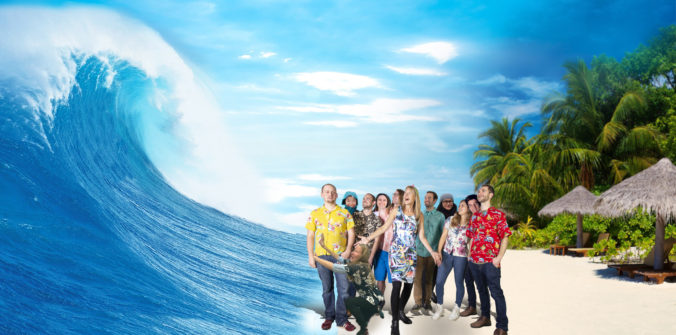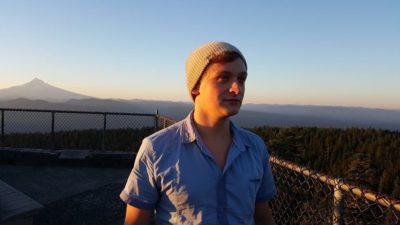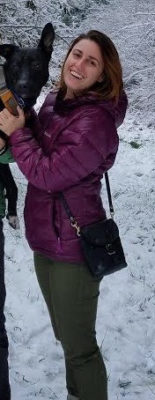Above: Halsey Lab most of our current members and some former members*: left to right (Alec Weaver*, Cleo Davie-Martin*, Kelsey McBeain*, Bryce Penta, Jordan Coehlo*, Riley Butler, me, Eric Moore*, Michelle Pombrol*, Teagan Couch, Duncan Ocel*, James Fox)
Post Doctoral Researchers
Dr. James Fox
James is a phytoplankton physiologist studying the linkages between expressions of algal growth and carbon export into the deep ocean. This work involves combining new measurements of physiology with optical and satellite retrievals. James’ research is part of the interdisciplinary NASA-funded EXPORTS project.
Graduate Students
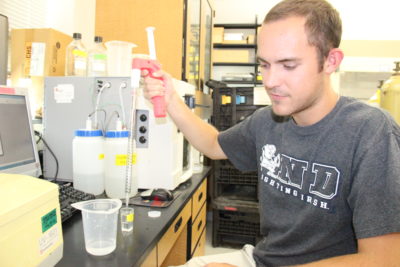 Bryce Penta
Bryce Penta
Bryce is pursuing a Ph.D. in Microbiology. He is interested in studying the impacts of mixotrophic metabolism on ecoystem production. Mixotrophs are abundant players in marine environments that can supplement photoautotrophic growth with direct consumption of preformed carbon. Bryce’s goal is to use new information about the physiological responses of these understudied protists to constrain ecosystem models. This is an exciting project that combines lab and field-based studies with computational modeling.
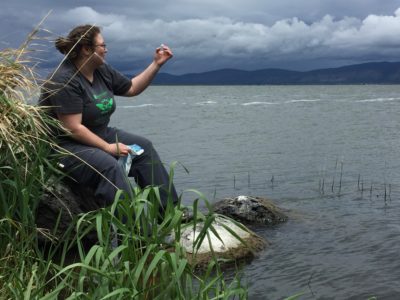 Lindsay Collart
Lindsay Collart
Lindsay is studying harmful algal blooms (HABs) in Oregon lakes. She has a wealth of knowledge of HABs in Lake Erie, and she is now expanding her knowledge to include understanding the community structure of cyanobacteria in HAB events and other ecological impacts of HABs. In particular, she is investigating the range of volatile organic compounds produced by these HABs. VOCs can be highly reactive in the atmosphere and can impact tropospheric ozone formation and air quality.
Undergraduate Students
Amanda Appel
Amanda is now a sophomore, having joined the lab as a freshman, beginning with media prep and culturing tasks. She came to OSU because of her enthusiasm (which is bountiful) for environmental microbiology. We are excited that she will have time to explore and participate in research over time…
Riley Butler
Riley is an Honors College student in Microbiology. He is working on his honors project studying the genetic controls of phytoplankton growth rate. We are happy to have his sharp mind and dedication to join our team.
Teagan Couch
Teagan joined the lab in her first week at OSU as a freshman! She is learning the ropes, culturing and working to grow a variety of algae under different light conditions.
Previous Lab Members
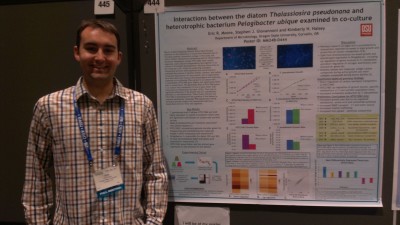 Eric Moore
Eric Moore
Eric completed his Ph.D. in Microbiology in Dec 2019. He studied phytoplankton-bacterial interactions using pure cultures and transcriptomic analyses. Along the way, Eric made an important and serendipitous discovery about how to trigger centric diatoms into the sexual lifecycle. His magic touch extended to the model centric species, Thalassiosira pseudonana, which has long been considered to be asexual. Through this work, Eric has found how exciting AND challenging it can be to make not one, but two landmark discoveries (see https://doi.org/10.1371/journal.pone.0181098) Eric’s graduate program has been supported by a Graduate Teaching Assistantship, funding from the Dept. of Microbiology Tartar Fund, and a Middlekauf Outstanding Graduate Teaching and Service Scholarship. He is now at the Los Alamos National Laboratory.
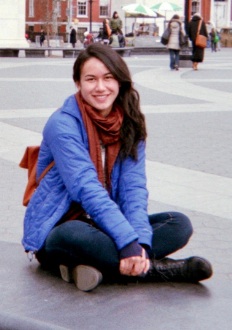 Michelle Pombrol
Michelle Pombrol
Michelle joined the lab with interest in applying bioinformatics to understanding plankton dynamics. She is studying the genetic controls of photosynthetic energy allocation in the model diatom, Thalassiosira pseudonana using transcriptomics. This work builds off of the lab’s efforts to understand how energy is partitioned into different metabolic pathways depending on growth rate. We anticipate discovering key genes involved in gating energy flow in the marine ecosystem. Michelle completed her MS in May, 2019, and is interested in pursuing technical writing.
Alec Weaver (MB)
Alec spent a term in the lab in 2018, and then took opportunity to participate in an REU program at BIOS (Bermuda Institute of Ocean Science). He returned to the lab ready to help with the many culturing studies we have ongoing. He is a wonderfully hard worker and has become a valuable member of our team. He is one of the few with great skill getting the often tricky-to-grow phytoplankton cells to proliferate. Alec is now working as a microbiologist at a company in Corvallis.
 Emma Tornberg (MB)
Emma Tornberg (MB)
Emma joined the lab in spring, 2018, to gain some research experience before heading towards medical school. She is helping to study physiological expressions of growth by mixotrophic algae under different environmental conditions. Mixotrophs are distinguished by their ability to use photosynthesis and consume existing carbon forms heterotrophically. This physiological flexibility complicates interpretations of carbon production by algae in the oceans. Emma is an enthusiastic member of the lab who was awarded a Sheila van Zandt scholarship to fund her research over the summer, 2018. Emma graduated in 2019, and will be applying to medical schools this coming year.
 Duncan Ocel (BPP, 2018)
Duncan Ocel (BPP, 2018)
Duncan is an Honors College student at OSU in the Dept. of Botany and Plant Pathology. He is combining traditional measurements of photosynthesis with our new PTR-MS technologies to study volatile organic carbon production by Synechococcus. Duncan was awarded a DeLoach work scholarship to fund his research in the Halsey lab. Now, he is attending graduate school at Montana State University.
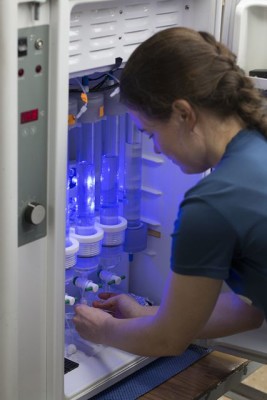 Dr. Cleo Davie-Martin
Dr. Cleo Davie-Martin
Cleo is an environmental scientist who studied the production and consumption of volatile organic carbon compounds by marine plankton during her four year post-doc at OSU. She used PTR-TOF-MS (proton transfer reaction time of flight mass spectrometer) combining new technology with unique incubation methods to study VOCs that are notoriously difficult to measure because of their low molecular weights and concentrations. Cleo is now continuing her work in Denmark where she is lab manager and applies her tremendous instrumentation skills to study atmospheric compounds in the Arctic.
Jordan Coehlo (MB, 2017-2018; now a Ph.D. student with Dr. J. Cameron Thrash)
Jordan is studied the physiology of the first generations of the diatom Thalassiosira pseudonana following sexual reproduction. She and grad student, Eric Moore, received the Sheila Van Zandt scholarship to fund her summer research that follows up on Eric’s exciting discovery. Jordan is persistent and creative, two qualities served her very well in this challenging project.
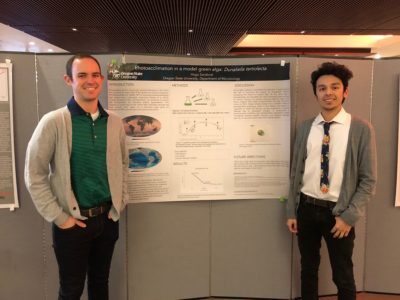 Hugo Sandoval (IB) STEM Leaders program (2017-2018)
Hugo Sandoval (IB) STEM Leaders program (2017-2018)
Hugo (right in the photo) is a student in the Integrative Biology program. He worked with grad student Bryce Penta to understand the timescales of acclimation. How quickly do cells respond to mixing events in aquatic systems? As a freshman he learned some of the basics of microbial cultivation culturing, and now in his second year, he conducted some of his own experiments collecting data on cell pigmentation and carbon content.
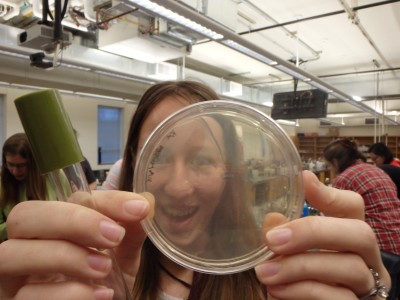 Kelsey McBeain (MS, Microbiology, 2016)
Kelsey McBeain (MS, Microbiology, 2016)
Kelsey graduated with an M.S. in Microbiology. She studied the effects of nutrient limitation on the transfer of energy between phytoplankton and microzooplankton ~ the first two trophic levels in the marine ecosystem. She used a unique culturing method to carry out this work. Her work has important implications for food web dynamics, especially in the face of expanding areas of nutrient depletion in the open ocean. She also received a Dick and Toshi Morita scholarship and she is now working as a lab technician in Alyson Santoro’s lab at UCSB.
Brianna Bullington (BS, Microbiology, 2016)
Brianna contributed to two major projects in the Halsey lab. She carefully conducted some diatom growth experiments that garnered her co-authorship on our paper about to be published in PLoS One. Brianna’s dedication to aquatic microbiology and environmental health is obvious. She is now working at the Vaccine and Gene Therapy Institute at OHSU.
Bethany Moua (BS, BioHealth Science, OSU Honors College, 2016)
Bethany completed her Honors thesis studying physiological acclimation strategies in green algae and diatoms. This work was part of a larger, NASA-funded effort to understand timescales of acclimation to nutrient availability. Her work showed very different responses in the two groups of algae that may have important consequences in carbon and energy trophic transfers.
 Nerissa Fisher (MS, 2015)
Nerissa Fisher (MS, 2015)
Nerissa graduated with an M.S. in Microbiology. She conducted a comprehensive evaluation of light limited photosynthetic energy use in the model diatom Thalassiosira pseudonana. A manuscript on this work was published in Photosynthesis Research and can be found here (Mechanisms that increase the growth efficiency of diatoms in low light). Nobody enjoys research cruises as much as Nerissa, and together, we had the opportunity to work in the Atlantic for 21 days on the NASA-supported SABOR cruise measuring primary production and diel carbon allocation. She worked as a research technician in the Behrenfeld lab at OSU as part of the NAAMES project before moving on to pursue a Ph.D. with Dr. David Suggett down under.
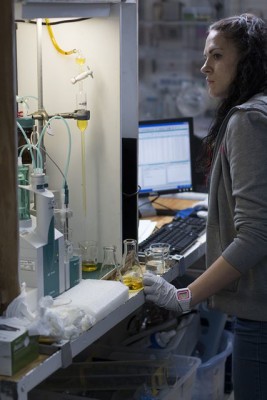 Dr. Bethan Jones (post-doctoral researcher, 2013-2015)
Dr. Bethan Jones (post-doctoral researcher, 2013-2015)
Bethan researched photosynthetic energy use strategies in nutrient limited Thalassiosira pseudonana. Her work has led to new insights on the molecular regulation of carbon assimilation and catabolism in response to nutrient-driven growth rate. She moved on to work as a post-doctoral researcher in the Behrenfeld lab at OSU where she developed new methods for measuring phytoplankton growth rate in the field.
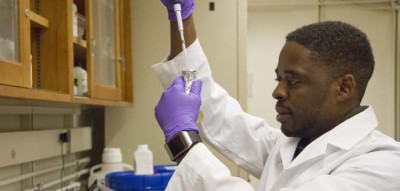 Marius Ibuye (BHS, UHC, 2015)
Marius Ibuye (BHS, UHC, 2015)
Marius graduated with a B.S. in BioHealth Sciences from OSU’s Honors College. He conducted his Honors thesis research on the effect of dark period duration on the growth of Synechococcus WH8102. He is now in the Pharm. D. program at Oregon State University. Marius’ story is one of inspiration and absolute positive conviction.
 Rachel Tullsen (MB, 2015)
Rachel Tullsen (MB, 2015)
Rachel graduated with a B.S. in Microbiology from OSU. She was the recipient of a URISC award that funded her undergraduate research on how the carbon composition of Synechococcus WH8102 changes in response to nutrient limitation. This was a challenging project, and Rachel’s perseverance was reflected in the success she found in developing specialized methods for growing these finicky open ocean cells in chemostat culture.
